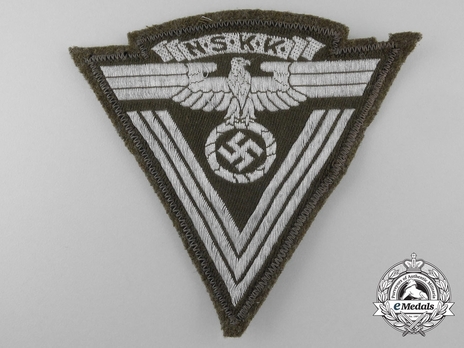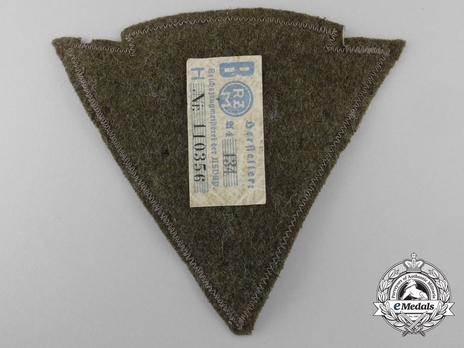NSKK Old Fighters Chevron (2nd pattern)
CATEGORY: Version
SKU: 53.GOR.03.02.05.002.001
Estimated market value:


Estimated market value:
Machine woven insignia, in aluminum/silvery flat-wires, on olive green/brown colored thick wool, 100mm x 95mm, excellent quality; reverse with a glued paper RZM tag, "Reichszeugmeisterei" (National-materiel-control-office); in extremely fine condition.
The NSKK (Nationalsozialistisches Kraftfahr-Korps = National Socialist Motor Corps) was a paramilitary organisation affiliated with the NSDAP, specialising in anything related to the driving of motorised vehicles. NSDAP officials recognised the need for access to cars and trucks for both transportation and propaganda purposes as early as 1922, and certain steps were taken to ensure this need was met. However, it took until April of 1930 for a specialised motor organisation to be officially founded. This organisation was named NSAK (Nationalsozialistisches Automobil-Korps = National Socialist Automobile Corps), but was renamed to NSKK less than 13 months later.
Initially, the NSAK/NSKK was under the control of the SA and existed next to its parent organisation’s own driving-related sub-organisation, the Motor-SA. This changed after the “Night of the Long Knives”, in which many SA leaders were purged and the organisation was substantially disempowered. After July of 1934, the NSKK became an independent organisation whose leader, NSKK-Korpsführer Adolf Hühnlein, answered directly to Adolf Hitler.
The main tasks of the NSKK were to provide transportation for all organisations of the Third Reich, to train and instruct boys and men (and a number of women) in mechanics and driving, and to assist police in regulating traffic. During the mid 1930s, the organisation also provided roadside assistance.
With the onset of the war, the NSKK’s tasks underwent certain changes. Instructing both civilians and soldiers in the driving and maintenance of armored vehicles became a higher priority. The NSKK also began working closely with other organisations, for example Organisation Todt (OT), by providing transportation of workers and supplies for the colossal building project that was the fortification of Germany’s Western border, the Siegfried Line (or Westwall). During the war, the NSKK provided much of the transportation needs for the German Army and the Luftwaffe, including the transport of troops, weapons and ammunition, and building materials, for example for the construction of air bases in the newly conquered territories in Eastern Europe after the attack on Soviet Russia in the summer of 1941.
Parts of the NSKK would come under the control of architect Albert Speer who took over OT after the death of Fritz Todt in 1942, leading to the creation of Transport Brigade Speer (later Transport Corps Speer), which would eventually completely sever its ties to the NSKK.
The so-called “Old Fighters” Chevron (Armwinkel für Alte Kämpfer) was worn by NSKK men who had already been members of the NSDAP, SA, SS, HJ, NSDStB, or the Stahlhelm prior to December 31, 1932. For members in Austria, the date was prior to January 1, 1937. This was later changed to December 31, 1937.
The insignia was worn on the upper right arm. It is in the form of a chevron made of aluminum trim with two interwoven brown stripes. The insignia is usually machine-woven, but hand-embroidered versions exist.
There are two patterns, with the first one worn from February 1934 until the introduction of the second pattern in 1938 or 1939.
On the first pattern, the chevron was sewn to a backing in the colour of the garment it was worn on. Sometimes there was no backing at all, and the chevron had just a small brown border instead.
When the sleeve eagle insignia was introduced, it was combined with the chevron by sewing the eagle onto the chevron’s backing, with the wreathed swastika of the eagle between the chevron’s arms.
With the second pattern, the chevron and the sleeve eagle insignia were produced as a single, combined insignia for economic reasons. The combined insignia was worn on the upper left arm, in keeping with the rules of the sleeve eagle insignia.
Members of NSKK motorboat units wore a gold-coloured chevron on a dark blue backing on the upper right arm. This version also exists as a first and second pattern.

Comments
Sign in to comment and reply.


Scroll Top